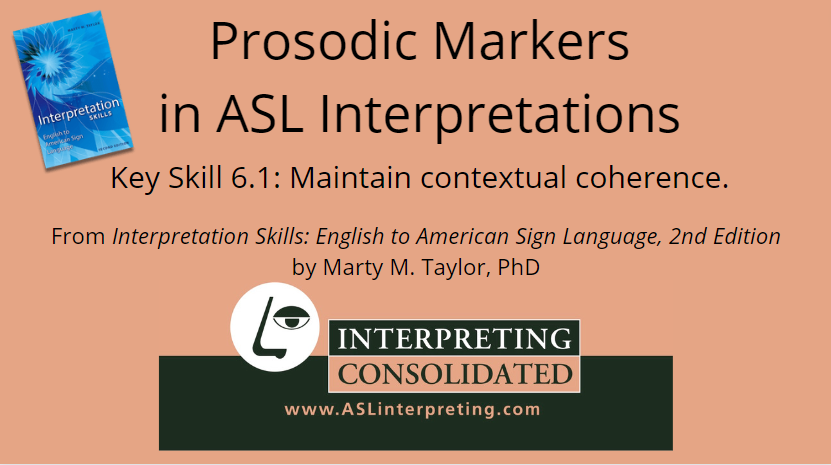From Interpretation Skills: English to American Sign Language, Second Edition
by Marty M. Taylor, PhD
Cohesion is an important aspect of coherence, and includes structural cohesion, grammatical cohesion, and semantic cohesion. Cohesion is the glue that holds the message together at each juncture, within and between sentences and within and between paragraphs. The boundaries of each utterance must be clearly evident. All of the information that relates to one aspect of the topic must be chunked together so that when new information is provided it can be chunked together in relation to the first topic and at the same time clearly introduced as a second topic. For example, “I was surprised to see my sister, and then I was surprised to see her with a boyfriend” would not be interpreted correctly if it were signed in a way that conveyed the meaning of “I was surprised when I saw my sister and her boyfriend,” because the source message specifies that the speaker was surprised by two events.
Prosody is an aspect of contextual coherence that overlaps the sub-skills in this Key Skill 6.1: Maintain contextual coherence. Prosody in ASL encompasses signing style characteristics that convey subtleties in the speaker’s delivery, such as mood, tone, and intensity. Specific ASL prosodic markers include head and body movements, holding and lengthening the production of signs, and lowering and clasping hands. As with other aspects of cohesion and coherence, prosody in the interpretation affects the ease, or the difficulty, with which the signer comprehends the interpreted message.
When prosody is absent or inconsistent, the target message lacks clarity and/or provides misleading information, leaving the signer with confusing or incomprehensible information about the content and/or the intention of the speaker. When prosodic markers are used in the interpretation, the likelihood of providing an overall coherent message is very high.
Examples of the Effect of Prosodic Markers in ASL and Written English
Absence of Prosodic Markers
The effect in ASL: The interpretation does not include beginnings or endings for each sign, sentence, or praragraph. Non-manual signals are not present.
The effect in Written English: The written text is a long string of letters without any spacing, capitalization, or punctuation.
fordandtoyotavehicleshavegoodrepairrecordsiprefertoyotasbutmypartner
ispartialtofordsbeforeyoubuyanyautomobilecheckonlineforthatmakeand
modelsrepairstatistics
Minimal Use of Prosodic Markers
The effect in ASL: The beginning and the end of each sign is evident. Each sentence has an ending, but the beginnings of subsequent sentences are not clearly evident. The signer must expend a great deal of effort in order to ascertain the meaning of the message.
The effect in Written English: Spaces separate words, and statements are followed by periods, but additional clarifying punctuation and capitalization are both absent.
ford and toyota vehicles have good repair records. i prefer toyotas but my partner is partial to fords. before you buy any automobile check online for that make and models repair statistics.
Effective Use of Prosodic Markers
The effect in ASL: Each sentence is produced completely, including accurate non-manual signals highlighting the beginning, middle, and end of each sentence and paragraph. The signer does not have to struggle to understand. Everything is in place to easily understand the speaker’s message.
The effect in Written English: Statements are in the form of complete sentences, and they include proper capitalization and correct punctuation.
Ford and Toyota vehicles have good repair records. I prefer Toyotas, but my partner is partial to Fords. Before you buy any automobile, check online for that make and model’s repair statistics.

